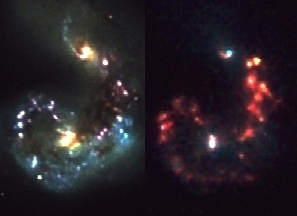
 A Galaxy Merger NASA Spitzer Space Telescope, the fourth of NASA great space observatories, launched in August 2003, is piercing the deep dust shrouds of the Universe. It's working in the infrared hence able to see deeply buried objects. This is a view of the Antennae galaxies, with the Spitzer Space Telescope view left and a visible view right. The infrared view is clearly showing a strong star formation rate where the two galaxies are merging. Galaxy mergers are the ultimate part of the galaxies evolution process. Spirals form from the mergers of compact "proto-galaxies" and of stars clusters as large ellipticals form from the mergers of spirals. Such mergers are always triggering massive star burst as such process is compressing entire zones of the galaxies just like a supernova is triggering such shockwaves, at a smaller scale, in gas clouds. Galaxy mergers are unfolding on geological time scales. The Antennae galaxies, NGC 4038, magnitude 10.3, and NGC 4039, magnitude 10.6, are located in the western part of the constellation Corvus, the Crow, 68 million light-years from us. Galaxies' centers are seen like bright dots (left) or yellow-bright nuclei (right). picture © site 'Amateur Astronomy' based on pictures NASA/JPL-Caltech/Z. Wang (Harvard-Smithsonian CfA) (left) and M. Rushing/NOAO (right)
A Galaxy Merger NASA Spitzer Space Telescope, the fourth of NASA great space observatories, launched in August 2003, is piercing the deep dust shrouds of the Universe. It's working in the infrared hence able to see deeply buried objects. This is a view of the Antennae galaxies, with the Spitzer Space Telescope view left and a visible view right. The infrared view is clearly showing a strong star formation rate where the two galaxies are merging. Galaxy mergers are the ultimate part of the galaxies evolution process. Spirals form from the mergers of compact "proto-galaxies" and of stars clusters as large ellipticals form from the mergers of spirals. Such mergers are always triggering massive star burst as such process is compressing entire zones of the galaxies just like a supernova is triggering such shockwaves, at a smaller scale, in gas clouds. Galaxy mergers are unfolding on geological time scales. The Antennae galaxies, NGC 4038, magnitude 10.3, and NGC 4039, magnitude 10.6, are located in the western part of the constellation Corvus, the Crow, 68 million light-years from us. Galaxies' centers are seen like bright dots (left) or yellow-bright nuclei (right). picture © site 'Amateur Astronomy' based on pictures NASA/JPL-Caltech/Z. Wang (Harvard-Smithsonian CfA) (left) and M. Rushing/NOAO (right)
Website Manager: G. Guichard, site 'Amateur Astronomy,' http://stars5.6te.net. Page Editor: G. Guichard. last edited: 12/28/2010. contact us at ggwebsites@outlook.com

